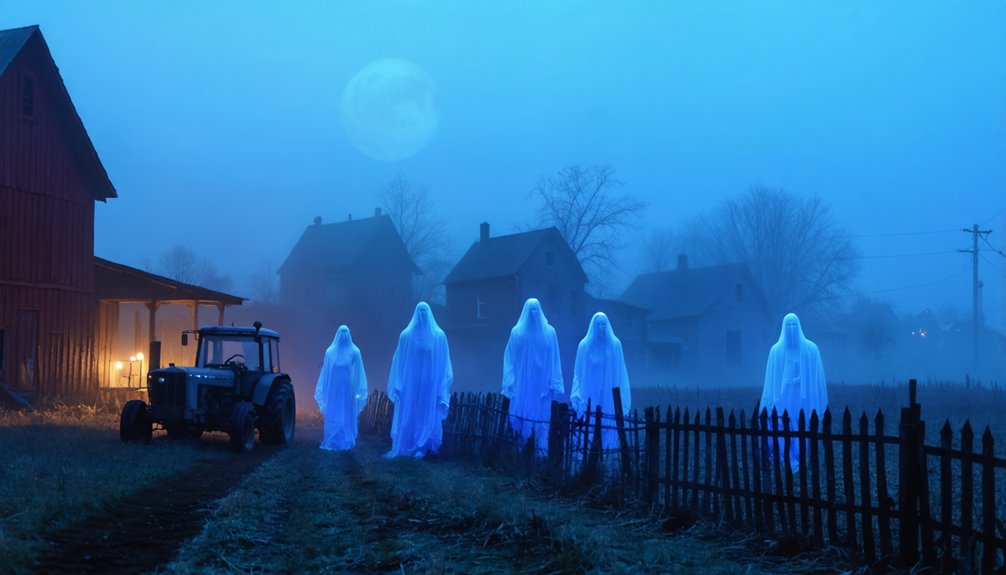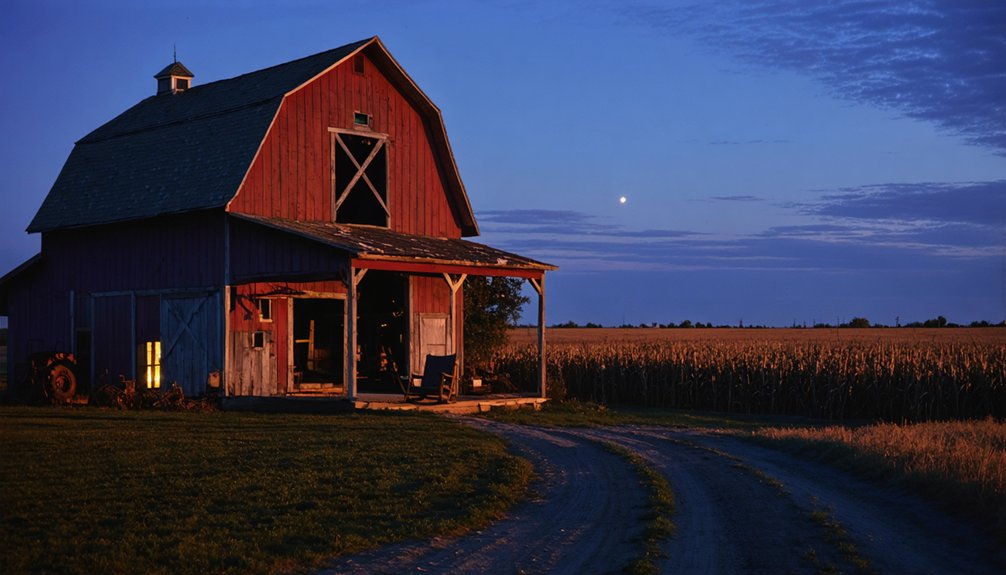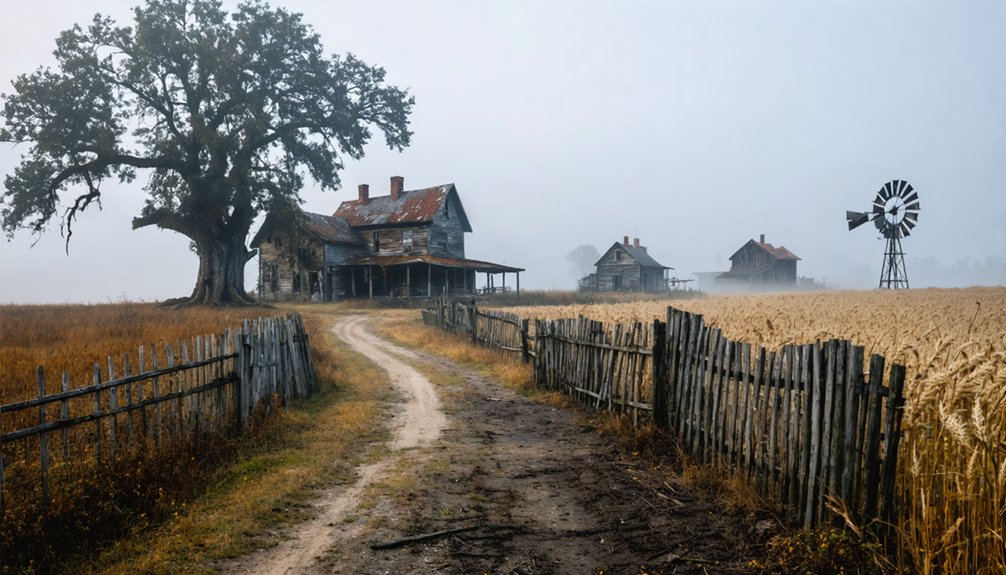To investigate ghostly farming village hauntings effectively, you’ll need historical context, proper equipment, and local connections. Begin by researching historical patterns through archives and family stories. Equip yourself with EMF meters, digital recorders, and thermal cameras for nighttime exploration. Document all evidence methodically with time-stamped logs. Build trust with residents by respecting their accounts and cultural beliefs. Always prioritize safety when exploring abandoned structures with a partner. These foundations will reveal the supernatural phenomena lurking in rural shadows.
Key Takeaways
- Document local stories in residents’ own words to preserve authentic accounts of ghostly phenomena in farming villages.
- Use EMF meters and thermal thermometers to detect anomalous readings in suspected haunted areas around abandoned farm structures.
- Research historical patterns through newspaper archives to establish credible chronologies of village hauntings.
- Prioritize safety with proper gear when exploring deteriorating farm buildings where paranormal activity is reported.
- Conduct nighttime investigations with partners using strategic placement of audio recorders to capture EVPs.
Recognizing Historical Patterns in Village Hauntings
When examining the historical patterns of village hauntings, one must recognize the consistent psychological and social mechanisms that have operated across centuries of documented paranormal phenomena.
The paranormal narrative of villages exists at the intersection of psychology, sociology, and centuries of documented phenomena.
You’ll find that coastal English villages in the 1700s experienced collective auditory phenomena before visual manifestations—a sequence that parallels Transylvanian forest village experiences.
These community-wide perceptions create what researchers identify as “gruesomely blurred” reality boundaries, where cultural rituals and community folklore reinforce supernatural explanations.
The chronology typically begins with unexplained events triggering mass hysteria, followed by sustained psychosis as collective experiences validate paranormal narratives.
When investigating historical hauntings, examine newspaper archives, epitaphs, and family ancestral stories for consistent patterns.
Note the seasonal timing and evening occurrences documented across multiple cases to establish credible chronologies of paranormal activity.
The village of Dunwich stands as a prime example where mass hysteria transformed a once-ordinary coastal community into a place permanently marked by its supernatural encounters.
Residual hauntings often manifest in agricultural communities where tragic events have created energy imprints that repeat themselves through generations of village inhabitants.
Essential Equipment for Nighttime Ghost Hunting
As darkness descends upon allegedly haunted locations, the proper equipment transforms an amateur outing into a methodical paranormal investigation.
You’ll need a high-lumen flashlight with adjustable brightness features to navigate safely while documenting potential phenomena. Supplement this with headlamps for hands-free operation in confined spaces.
EMF meters constitute your primary detection tool—sweep them slowly through suspected areas to map anomalous readings while distinguishing between natural and paranormal sources.
Pair these with digital voice recorders to capture EVPs outside human hearing range.
Thermal thermometers help you identify cold spots commonly associated with spirit activity. A smartphone’s multi-functionality can serve as backup for your specialized equipment, offering additional audio recording, photography, and note-taking capabilities when needed.
For team coordination in larger farming villages, utilize walkie-talkies rather than cell phones, which may introduce electromagnetic interference.
Complete your toolkit with cameras capable of infrared capture to document visual evidence of the paranormal domain.
Remember to cross-verify evidence from multiple devices to strengthen the credibility of your findings and eliminate false positives.
Documenting Paranormal Evidence With Modern Technology
Modern paranormal investigators rely on sophisticated technology to capture evidence that earlier generations of ghost hunters could only dream of documenting.
When investigating farming village hauntings, you’ll need to implement a multi-layered approach to documentation.
Utilize high-definition video analysis in conjunction with thermal imaging to detect visual anomalies across the light spectrum. Position multiple audio recorders throughout the site to conduct strategic EVP techniques—ask direct questions followed by silent intervals to encourage spirit responses. Cross-reference these recordings with your EMF and temperature readings to identify correlations between environmental fluctuations and captured phenomena.
Always maintain meticulous time-stamped logs of all data collected, noting when and where anomalies occur. This systematic documentation process enables you to differentiate between genuine paranormal evidence and environmental interference, strengthening the credibility of your findings during post-investigation analysis. Be mindful of environmental factors that might create misleading visual effects which could be misinterpreted as paranormal activity. Remember to investigate with a partner or group for safety reasons and to have multiple witnesses for any potential encounters.
Building Trust With Local Residents and Their Stories
Building meaningful relationships with local residents forms the cornerstone of effective paranormal investigation in farming villages, where centuries of oral tradition often preserve accounts of supernatural phenomena more accurately than written records.
Your community engagement strategy should prioritize authentic connections over expedient data collection.
Authentic human connections must precede data gathering when investigating the paranormal in close-knit rural communities.
When conducting narrative collection, consider:
- Documenting accounts in witnesses’ own words, preserving their unique perspective and cultural context
- Recording precise details including times, dates, and weather conditions associated with paranormal events
- Establishing trust with local historians and property owners before requesting access to sites
- Demonstrating respect for cultural beliefs that may interpret spiritual phenomena through Taoist, Confucian, or Buddhist frameworks
Always bring a partner when conducting interviews or site visits, as safety in numbers provides validation of experiences and reduces risks in unfamiliar rural environments.
This relationship-centered approach yields not only superior evidence but creates sustainable partnerships that honor community interests rather than pursuing sensationalism that undermines local trust. According to a 2005 Gallup poll, 32% of Americans believe in ghosts, showing how prevalent supernatural beliefs are across different communities.
Staying Safe While Exploring Abandoned Farm Structures
Exploring abandoned farm structures requires methodical assessment of physical hazards that paranormal investigators often overlook when pursuing evidence of supernatural activity.
Begin by evaluating structural integrity through visual inspection of roofs, foundations, and interior framing, avoiding areas with severe damage like excessive roof sagging or tilted support columns.
Always equip yourself with proper safety gear: sturdy boots with ankle support, protective gloves, helmets, and eye protection. Dust masks are essential to filter potentially harmful particles when exploring dilapidated structures with accumulated debris.
Research the site’s history to anticipate hazardous zones such as pits or chemical storage areas. Carry essential supplies including first aid kits, reliable lighting, and communication devices.
Before entering any building, check floors for instability and be vigilant for head-bump hazards. Look for potential entry points of water by inspecting the building from the inside for structural separations at ridges and gable ends.
Remember that weather conditions can further weaken structures, so timing your exploration appropriately is vital for both personal safety and paranormal investigation success.
Frequently Asked Questions
Can Ghosts Attach Themselves to Visitors and Follow Them Home?
Yes, ghost attachments can follow you home. Your psychic sensitivity often influences these visitor experiences more than location itself. Energy compatibility, not residency status, determines attachment vulnerability.
How Do You Distinguish Between Natural Phenomena and Genuine Paranormal Activity?
Cold as science, you’ll distinguish paranormal signs from natural explanations by documenting recurring phenomena across multiple witnesses, collecting empirical evidence, eliminating mundane causes, and analyzing data through rigorous baseline environmental comparisons.
Do Animals Sense Ghostly Presences Before Humans Do?
Animals may detect environmental changes humans miss. Your pet’s unusual behaviors might indicate ghostly presences through their heightened instincts, though science attributes this to their superior sensory capabilities rather than paranormal sensitivity.
What Spiritual Protection Methods Work Best During Investigations?
Over 75% of investigators report enhanced safety through layered protection. You’ll find spiritual cleansing with sage removes residual energies, while carrying protective crystals like black tourmaline establishes energetic boundaries during paranormal encounters.
Can Weather Conditions Affect the Likelihood of Encountering Spirits?
Yes, weather patterns notably influence spirit encounters. You’ll notice increased manifestations during thunderstorms and humidity changes. Research indicates seasonal hauntings correlate with atmospheric pressure fluctuations and temperature variations in haunted locations.
References
- https://www.morningagclips.com/the-ghostly-legends-of-americas-haunted-farms/
- https://bnu.repository.guildhe.ac.uk/id/eprint/20221/1/20221_Okeeffe.pdf
- https://seelincolncounty.com/haunted-farms-genoa/
- https://www.ghostsandgravestones.com/how-to-ghost-hunt
- https://customshousemuseum.org/news/the-bell-witch-the-scariest-ghost-story-in-tennessee/
- https://www.youtube.com/watch?v=bGi9Y0tsT5w
- http://passionforthepast.blogspot.com/2015/04/ghosts-of-greenfield-village.html
- https://en.wikipedia.org/wiki/Ghost_hunting
- https://www.ourhauntedtravels.com/post/hale-farms-civil-war-and-hauntings
- https://www.youtube.com/watch?v=1e97GfzLf3A



